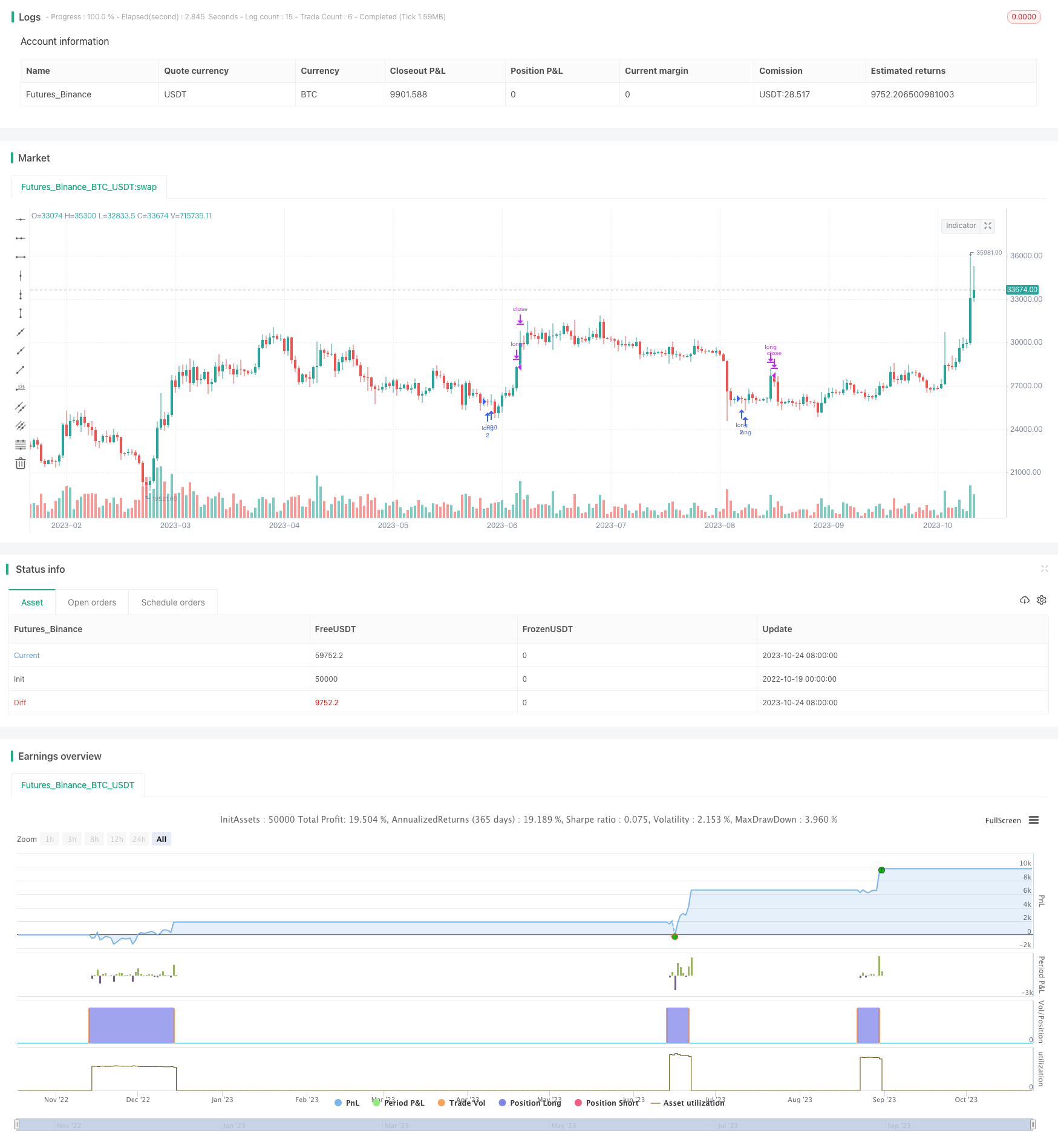다중 지표 조합 거래 전략
저자:차오장, 날짜: 2023-10-26 15:22:28태그:

전반적인 설명
이 전략은 CCI, ADX 및 AO 지표를 결합하여 긴 및 짧은 포지션을위한 거래 신호를 생성합니다. CCI는 과반 구매 및 과반 판매 수준을 식별하고, ADX는 트렌드 강도와 방향을 결정하며, AO는 변동하는 시장을 지원합니다. 다중 지표 조합은 거래 시스템의 안정성과 효율성을 향상시킵니다.
전략 논리
-
CCI는 100 이상의 과잉 구매와 -100 이하의 과잉 판매를 나타냅니다. CCI가 0 이하인 경우 이 전략은 길게 진행됩니다.
-
ADX는 트렌드 강도를 측정합니다. DI+는 상승 트렌드 강도를 나타냅니다. DI-는 하락 트렌드 강도를 나타냅니다. ADX는 평균 트렌드 강도를 나타냅니다. 이 전략은 DI+가 25보다 낮을 때 길어집니다.
-
AO는 빠른 SMA 빼기 느린 SMA입니다. 상승하는 AO는 상승 동력을 강화하고, 떨어지는 AO는 하락 동력을 강화하는 것을 나타냅니다. 이 전략은 AO가 0보다 낮을 때 길어집니다.
-
거래 규칙은: CCI < 0과 DI+ < 25과 AO < 0이 되면 긴 거래를 하고, DI+ > 25이 되면 긴 거래를 한다.
-
동적으로 명령의 크기를 자금으로 나누고 닫기 가격으로 종전하여 계산하여 계정 자금 변경에 따라 주문을 조정합니다.
-
긴 신호를 위해 전략.입구, 출구 신호를 위해 전략.결결을 사용하세요.
장점
-
CCI는 다양한 시장의 잡음을 필터링하여 잘못된 신호를 줄입니다.
-
ADX는 더 강한 경향을 일찍 파악합니다.
-
AO는 불안한 시장에서 거래를 피합니다.
-
여러 지표가 신호를 확인해 신뢰성을 높여줍니다.
-
역동적인 위치 크기는 위험을 효과적으로 관리합니다.
-
단순하고 명확한 논리, 따라하기 쉽다.
위험성
-
CCI는 vkosd 범위를 식별하는데 어려움을 겪습니다.
-
ADX는 트렌드 전환에 지연하고 있습니다.
-
AO는 불안한 통합에 어려움을 겪고 있습니다.
-
나쁜 지표 설정은 과도한 필터링과 놓친 거래를 초래합니다.
-
변동성과 시장에 따라 동적 크기가 결정됩니다.
-
큰 마취 가능성, 엄격한 위험 관리가 필요합니다.
개선
-
다양한 시장에 대한 CCI 매개 변수를 최적화합니다.
-
ADX 매개 변수를 최적화하여 트렌드 변화를 감지합니다.
-
변동성 환경에 대한 AO 매개 변수를 조정합니다.
-
최적의 지표 가중치를 찾기 위한 테스트 조합
-
마감 제어에 스톱 손실을 추가하세요
-
가짜 탈출을 피하기 위해 부피를 포함합니다.
-
기기별로 고정된 위치 크기를 조정합니다.
결론
이 전략은 CCI, ADX 및 AO를 결합하여 상당히 신뢰할 수 있는 긴 신호를 생성합니다. 동적 사이즈링 및 위치 관리 위험 제어. 논리는 초보자가 따르기 위해 간단하고 명확합니다. 그러나 다른 시장에 필요한 상당한 최적화 잠재력으로 다양한 시장에서 어려움을 겪고 있습니다. 도구 및 환경 전반에 걸쳐 견고성을 위해 추가 테스트 및 조정이 필요합니다.
/*backtest
start: 2022-10-19 00:00:00
end: 2023-10-25 00:00:00
period: 1d
basePeriod: 1h
exchanges: [{"eid":"Futures_Binance","currency":"BTC_USDT"}]
*/
//@version=3
strategy("Strategy Niel", shorttitle="Strategy Niel", max_bars_back=2000, initial_capital=1000)
//Input variables
buywhenadxabove = input(25)
buywhendiplusbelow = input(10)
buywhenccibelow = input(0)
buywhenawesomeoscillatorbelow = input(0)
sellwhendiplusabove = input(25)
//CCI script
numberofbarsforcci = input(20)
CCI = cci(close,numberofbarsforcci)
//+DI and ADX
adxlen = input(14, title="ADX Smoothing")
dilen = input(14, title="DI Length")
dirmov(len) =>
up = change(high)
down = -change(low)
truerange = rma(tr, len)
plus = fixnan(100 * rma(up > down and up > 0 ? up : 0, len) / truerange)
minus = fixnan(100 * rma(down > up and down > 0 ? down : 0, len) / truerange)
[plus, minus]
adx(dilen, adxlen) =>
[plus, minus] = dirmov(dilen)
sum = plus + minus
adx = 100 * rma(abs(plus - minus) / (sum == 0 ? 1 : sum), adxlen)
[adx, plus, minus]
[sig, up, down] = adx(dilen, adxlen)
//plot(sig, color=red, title="ADX")
//plot(up, color=blue, title="+DI")
//plot(down, color=orange, title="-DI")
//Awesome Oscillator
nLengthSlow = input(34, minval=1, title="Length Slow")
nLengthFast = input(5, minval=1, title="Length Fast")
xSMA1_hl2 = sma(hl2, nLengthFast)
xSMA2_hl2 = sma(hl2, nLengthSlow)
xSMA1_SMA2 = xSMA1_hl2 - xSMA2_hl2
cClr = xSMA1_SMA2 > xSMA1_SMA2[1] ? blue : red
//plot(xSMA1_SMA2, style=histogram, linewidth=1, color=cClr)
buy = sig > buywhenadxabove and up < buywhendiplusbelow and CCI < buywhenccibelow and xSMA1_SMA2 < buywhenawesomeoscillatorbelow
ordersize=floor(strategy.equity/close) // Floor returns largest integer, strategy.equity gives total equity remaining - allows to dynamically calculate the order size as the account equity increases or decreases.
strategy.entry("long",strategy.long,ordersize,when= buy) //strategy.entry let's you enter the market variables id ("long"), strategy.long (long position entry), size of the order and when the order should happen
bought = strategy.position_size[0] > strategy.position_size[1]
entry_price = valuewhen(bought, open, 0)
sell = up > sellwhendiplusabove
strategy.close("long", when=sell ) //strategy.close let's you close your position with variables id ('long') and when this should happen
- 이중 이동 평균 반전 및 삼중 하위 플래시 컴보 거래 전략
- 평균 스토카스틱 거래 전략
- 변동성 힘 돌파구 거래 전략
- 삼중 지표 동력 역전 전략
- 격차 거래 이동 평균 전략
- 돈치안 채널 적응 트렌드 전략
- MACD 제어 위험 거래 전략
- 전략에 따른 RSI 트렌드
- 이동평균에 기초한 평균 회전 거래 전략
- EMA 평균 회전 거래 전략
- 다중 요인 전략 조합
- 투표 전략은 막힌다.
- 2단계 스톱 로스 전략
- 다중 지표에 기초한 양적 거래 전략
- 거래 전략에 따른 가격 격차와 추세
- 브레이크아웃 스칼퍼 - 트렌드 변화를 빠르게 파악
- EMA의 크로스오버 추적 전략
- 트레일링 스톱 손실과 함께 SSL 채널 브레이크업 전략
- CCI의 추진력 추적 전략
- 점진적 축적 브레이크아웃 거래 전략